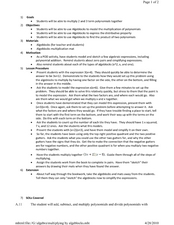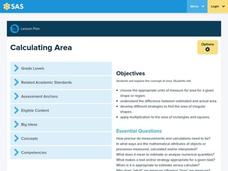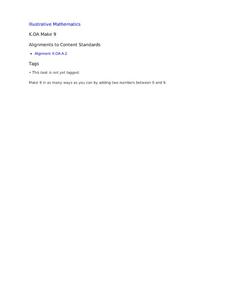Google
Properties of + and x Foldable
Clarify for young scholars the basic properties of addition and multiplication with this foldable math resource. Written on the front flaps are the terms commutative, associative, identity, and inverse...
Curated OER
Hands-On Equations: Teacher Notes
Math manipulatives are wonderful for demonstrating any number of mathematical concepts in a concrete and visual way. Learners review the addition property of equality and the zero property using a scale model kit (not shown). They...
EngageNY
Choosing a Model
There's a function for that! Scholars examine real-world situations to determine which type of function would best model the data in the 23rd installment of a 35-part module. It involves considering the nature of the data in addition to...
EngageNY
Writing Addition and Subtraction Expressions
Symbols make everything so much more concise. Young mathematicians learn to write addition and subtraction expressions — including those involving variables — from verbal phrases. Bar models help them understand the concept.
Scholastic
Study Jams! Multiplication
What does baking cupcakes have to do with multiplication? Watch this video and find out as your class learns that multiplication is the repeated addition of equal groups. Properties of multiplication are also introduced with...
Curated OER
Commutative Property
First graders use various models to learn the Commutative Property of Addition. In this Commutative Property lesson, 1st graders use other students, counters, balances, and dominoes to apply the addition property. Students solve addition...
Curated OER
Developing Strategies for Addition and Subtraction
Primary graders develop strategies to assist them with addition and subtraction. They discover number combinations and numerical facts which enable them to add and subtract more effectively. Students use these techniques to complete...
Curated OER
Making a Ten
An addition table supports third graders as they learn strategies to improve their math fluency. When finding sums greater than ten, students are taught how to first make a ten and then add on the rest. A similar method is also...
EngageNY
The Distributive Property and the Products of Decimals
Make multiplication of decimals easier by applying the distributive property. Pupils investigate how they can use the distributive property to multiply decimals. After learning the strategy, they work on some practice problems at...
EngageNY
Addition and Subtraction Formulas 2
Knowing the addition formulas allows for the calculations of double and half formulas. The fourth installment of 16 has the class use the addition formula to develop the double angle trigonometric formulas. Using the double formula,...
CK-12 Foundation
Properties of Multiplication in Decimal Operations: Balloon Animals
Commutive and associative properties are the focus of a five-question interactive. Dealing with decimal multiplication and addition, mathematicians solve multiple-choice and true or false questions using a model that moves balloons along...
CK-12 Foundation
Distributive Property: Catching Fireflies
Model the distributive property with jars of fireflies! An interactive animation has learners manipulate the number of jars of fireflies to determine the number caught. Accompanying questions ask scholars to consider the multiplication...
US Environmental Protection Agency
Aquifer in a Cup
Young scientists create their very own aquifers in this science lesson on ground water. After learning about how some people get their drinking water from underground wells, young learners use sand, modeling clay, and aquarium rocks to...
Curated OER
Properties
Seventh graders explore the concept of properties. In this properties lesson plan, 7th graders discuss the various math properties including the commutative, associative, distributive, multiplication properties and so on. Students create...
Curated OER
Match the Number Sentence!
Matching number sentences to their visual equivalents may seem easy, but there is a trick here to keep your learners thinking about math properties. As they examine the numerical forms of six addition problems, they must...
Curated OER
Students Multiply Polynomials
Factor polynomial functions that have two and three terms. Using Algeblocks, your class will create models to show their understanding of these concepts.
Curated OER
Teaching About Plate Tectonics and Faulting Using Foam Models
Young scientists learn about plate tectonics and the three different types of faults (normal, reverse, and strike-slip) using foam models. The activity also covers common types of locations where these faults are found.
EngageNY
Replacing Letters with Numbers II
Teach about properties properly. Individuals investigate the commutative and identity properties for both addition and multiplication. They see that the properties hold true for all values by using substitution to test out several examples.
Curated OER
Distribution Property Of Multiplication Over Addition
Fourth graders complete problems where they demonstrate their knowledge of the distributive property of multiplication. In this distributive property lesson plan, 4th graders are provided with worksheets.
Curated OER
Addition - Decimals
In this decimal addition worksheet, students solve 15 problems that require them to add decimal numbers with 1-5 digits.
Curated OER
Properties of Multiplication
Fifth graders examine the process of multiplication and the relationship between addition and multiplication. They observe the teacher model a variety of problems on the board, and identify properties of multiplication. Students...
Pennsylvania Department of Education
Multiplication Using Arrays
Explore the concept of multiplication by using arrays. Classmates use arrays to gain a better understanding of multiplication. They break arrays apart to model the distributive property of multiplication over addition. The relationship...
Illustrative Mathematics
Make 9
Learning how numbers are put together as parts and wholes is a big step in building the foundational number sense of young mathematicians. Here, children are given a number less than 10 and are asked to find as many pairs of numbers as...
LABScI
Atomic Structure and the Periodic Table of Elements: The Secret Agent Lab
Food always gets attention! Model atomic structure using fruit loops to represent the subatomic particles. After building models, scholars create ionic bonds using their models. Finally, they use these concepts to create a periodic...

























